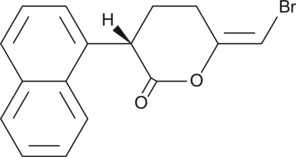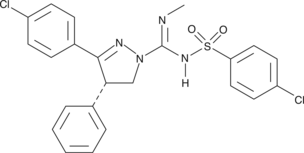Chemicals
Showing 1351–1500 of 41137 results
-
(S)-AM1241 binds to cannabinoid (CB) receptors and is selective for the CB2 over the CB1 receptor (Kis = 658 and >10,000 nM, respectively, in a membrane assay using human receptors).{18107} (S)-1241 acts as an agonist at human, rat, and mouse CB2 receptors but shows greater activity at human CB2 (EC50 = 131 nM) than at rat and mouse CB2 receptors (EC50 = 785 and 2,000 nM, respectively). Similar to the racemate AM1241 (Item No. 10010118), (S)-AM1241 produces antinociception to thermal, but not mechanical, pain in rats.{18108} The pain-reducing effect of (S)-AM1241 is blocked by the CB2-specific inhibitor SR 144528 (Item No. 9000491) but not by either the CB1-selective inhibitor rimonabant (Item No. 9000484) or the opioid receptor blocker naloxone (Item No. 15594 | ISO60191).
Brand:CaymanSKU:10490 - 1 mgAvailable on backorder
-
(S)-AM1241 binds to cannabinoid (CB) receptors and is selective for the CB2 over the CB1 receptor (Kis = 658 and >10,000 nM, respectively, in a membrane assay using human receptors).{18107} (S)-1241 acts as an agonist at human, rat, and mouse CB2 receptors but shows greater activity at human CB2 (EC50 = 131 nM) than at rat and mouse CB2 receptors (EC50 = 785 and 2,000 nM, respectively). Similar to the racemate AM1241 (Item No. 10010118), (S)-AM1241 produces antinociception to thermal, but not mechanical, pain in rats.{18108} The pain-reducing effect of (S)-AM1241 is blocked by the CB2-specific inhibitor SR 144528 (Item No. 9000491) but not by either the CB1-selective inhibitor rimonabant (Item No. 9000484) or the opioid receptor blocker naloxone (Item No. 15594 | ISO60191).
Brand:CaymanSKU:10490 - 10 mgAvailable on backorder
-
(S)-AM1241 binds to cannabinoid (CB) receptors and is selective for the CB2 over the CB1 receptor (Kis = 658 and >10,000 nM, respectively, in a membrane assay using human receptors).{18107} (S)-1241 acts as an agonist at human, rat, and mouse CB2 receptors but shows greater activity at human CB2 (EC50 = 131 nM) than at rat and mouse CB2 receptors (EC50 = 785 and 2,000 nM, respectively). Similar to the racemate AM1241 (Item No. 10010118), (S)-AM1241 produces antinociception to thermal, but not mechanical, pain in rats.{18108} The pain-reducing effect of (S)-AM1241 is blocked by the CB2-specific inhibitor SR 144528 (Item No. 9000491) but not by either the CB1-selective inhibitor rimonabant (Item No. 9000484) or the opioid receptor blocker naloxone (Item No. 15594 | ISO60191).
Brand:CaymanSKU:10490 - 25 mgAvailable on backorder
-
(S)-AM1241 binds to cannabinoid (CB) receptors and is selective for the CB2 over the CB1 receptor (Kis = 658 and >10,000 nM, respectively, in a membrane assay using human receptors).{18107} (S)-1241 acts as an agonist at human, rat, and mouse CB2 receptors but shows greater activity at human CB2 (EC50 = 131 nM) than at rat and mouse CB2 receptors (EC50 = 785 and 2,000 nM, respectively). Similar to the racemate AM1241 (Item No. 10010118), (S)-AM1241 produces antinociception to thermal, but not mechanical, pain in rats.{18108} The pain-reducing effect of (S)-AM1241 is blocked by the CB2-specific inhibitor SR 144528 (Item No. 9000491) but not by either the CB1-selective inhibitor rimonabant (Item No. 9000484) or the opioid receptor blocker naloxone (Item No. 15594 | ISO60191).
Brand:CaymanSKU:10490 - 5 mgAvailable on backorder
-
(S)-BAY-598 is a selective inhibitor of SMYD2. It inhibits the methylation of p53 at lysine 370 in vitro and in whole cells with IC50 values of 27 nM and Structural Genomics Consortium (SGC). The negative control, BAY-369, for (S)-BAY-598 is also available exclusively through the SGC. You can submit a request to receive the negative control here.
Brand:CaymanSKU:-Available on backorder
-
(S)-BAY-598 is a selective inhibitor of SMYD2. It inhibits the methylation of p53 at lysine 370 in vitro and in whole cells with IC50 values of 27 nM and Structural Genomics Consortium (SGC). The negative control, BAY-369, for (S)-BAY-598 is also available exclusively through the SGC. You can submit a request to receive the negative control here.
Brand:CaymanSKU:-Available on backorder
-
(S)-BAY-598 is a selective inhibitor of SMYD2. It inhibits the methylation of p53 at lysine 370 in vitro and in whole cells with IC50 values of 27 nM and Structural Genomics Consortium (SGC). The negative control, BAY-369, for (S)-BAY-598 is also available exclusively through the SGC. You can submit a request to receive the negative control here.
Brand:CaymanSKU:-Available on backorder
-
(S)-BAY-598 is a selective inhibitor of SMYD2. It inhibits the methylation of p53 at lysine 370 in vitro and in whole cells with IC50 values of 27 nM and Structural Genomics Consortium (SGC). The negative control, BAY-369, for (S)-BAY-598 is also available exclusively through the SGC. You can submit a request to receive the negative control here.
Brand:CaymanSKU:-Available on backorder
-
The phospholipases are an extensive family of lipid hydrolases that function in cell signaling, digestion, membrane remodeling, and as venom components.{6940} The calcium-independent phospholipases (iPLA2) are a PLA2 subfamily closely associated with the release of arachidonic acid in response to physiologic stimuli. (S)-Bromoenol lactone ((S)-BEL) is an irreversible, chiral, mechanism-based inhibitor of calcium-independent phospholipase β (iPLA2β) that inhibits the vasopressin-induced release of arachidonate from cultured rat aortic smooth muscle (A10) cells with an IC50 value of 2 µM.{12978} (S)-BEL is more than 1,000-fold selective for iPLA2 versus cPLA2, and is 10-fold selective for iPLA2β versus iPLA2γ.
Brand:CaymanSKU:10006801 - 1 mgAvailable on backorder
-
The phospholipases are an extensive family of lipid hydrolases that function in cell signaling, digestion, membrane remodeling, and as venom components.{6940} The calcium-independent phospholipases (iPLA2) are a PLA2 subfamily closely associated with the release of arachidonic acid in response to physiologic stimuli. (S)-Bromoenol lactone ((S)-BEL) is an irreversible, chiral, mechanism-based inhibitor of calcium-independent phospholipase β (iPLA2β) that inhibits the vasopressin-induced release of arachidonate from cultured rat aortic smooth muscle (A10) cells with an IC50 value of 2 µM.{12978} (S)-BEL is more than 1,000-fold selective for iPLA2 versus cPLA2, and is 10-fold selective for iPLA2β versus iPLA2γ.
Brand:CaymanSKU:10006801 - 10 mgAvailable on backorder
-
The phospholipases are an extensive family of lipid hydrolases that function in cell signaling, digestion, membrane remodeling, and as venom components.{6940} The calcium-independent phospholipases (iPLA2) are a PLA2 subfamily closely associated with the release of arachidonic acid in response to physiologic stimuli. (S)-Bromoenol lactone ((S)-BEL) is an irreversible, chiral, mechanism-based inhibitor of calcium-independent phospholipase β (iPLA2β) that inhibits the vasopressin-induced release of arachidonate from cultured rat aortic smooth muscle (A10) cells with an IC50 value of 2 µM.{12978} (S)-BEL is more than 1,000-fold selective for iPLA2 versus cPLA2, and is 10-fold selective for iPLA2β versus iPLA2γ.
Brand:CaymanSKU:10006801 - 5 mgAvailable on backorder
-
The phospholipases are an extensive family of lipid hydrolases that function in cell signaling, digestion, membrane remodeling, and as venom components.{6940} The calcium-independent phospholipases (iPLA2) are a PLA2 subfamily closely associated with the release of arachidonic acid in response to physiologic stimuli. (S)-Bromoenol lactone ((S)-BEL) is an irreversible, chiral, mechanism-based inhibitor of calcium-independent phospholipase β (iPLA2β) that inhibits the vasopressin-induced release of arachidonate from cultured rat aortic smooth muscle (A10) cells with an IC50 value of 2 µM.{12978} (S)-BEL is more than 1,000-fold selective for iPLA2 versus cPLA2, and is 10-fold selective for iPLA2β versus iPLA2γ.
Brand:CaymanSKU:10006801 - 500 µgAvailable on backorder
-
(S)-CR8 is a second generation derivative of (R)-roscovitine (Item No. 10009569) and an inhibitor of cyclin-dependent kinase 1 (Cdk1/cyclin B), Cdk2/cyclin A, Cdk2/cyclin E, Cdk5/p25, and Cdk9/cyclin T (IC50s = 0.15, 0.08, 0.06, 0.12, and 0.11 µM, respectively).{21811} It also inhibits casein kinase CK1δ/ε (CKδ/ε) and DYRK1A (IC50s = 0.61 and 0.9 µM, respectively). (S)-CR8 reduces cell viability in human neuroblastoma cell lines, including SH-SY5Y, SK-N-AS, SK-N-BE, and IMR32 cells (IC50s = 0.43, 1.46, 0.13, and 0.14 µM, respectively).{21810} It also reduces protein levels of the survival factor Mcl-1 in SH-SY5Y cells.
Brand:CaymanSKU:29985 - 1 mgAvailable on backorder
-
(S)-CR8 is a second generation derivative of (R)-roscovitine (Item No. 10009569) and an inhibitor of cyclin-dependent kinase 1 (Cdk1/cyclin B), Cdk2/cyclin A, Cdk2/cyclin E, Cdk5/p25, and Cdk9/cyclin T (IC50s = 0.15, 0.08, 0.06, 0.12, and 0.11 µM, respectively).{21811} It also inhibits casein kinase CK1δ/ε (CKδ/ε) and DYRK1A (IC50s = 0.61 and 0.9 µM, respectively). (S)-CR8 reduces cell viability in human neuroblastoma cell lines, including SH-SY5Y, SK-N-AS, SK-N-BE, and IMR32 cells (IC50s = 0.43, 1.46, 0.13, and 0.14 µM, respectively).{21810} It also reduces protein levels of the survival factor Mcl-1 in SH-SY5Y cells.
Brand:CaymanSKU:29985 - 10 mgAvailable on backorder
-
(S)-CR8 is a second generation derivative of (R)-roscovitine (Item No. 10009569) and an inhibitor of cyclin-dependent kinase 1 (Cdk1/cyclin B), Cdk2/cyclin A, Cdk2/cyclin E, Cdk5/p25, and Cdk9/cyclin T (IC50s = 0.15, 0.08, 0.06, 0.12, and 0.11 µM, respectively).{21811} It also inhibits casein kinase CK1δ/ε (CKδ/ε) and DYRK1A (IC50s = 0.61 and 0.9 µM, respectively). (S)-CR8 reduces cell viability in human neuroblastoma cell lines, including SH-SY5Y, SK-N-AS, SK-N-BE, and IMR32 cells (IC50s = 0.43, 1.46, 0.13, and 0.14 µM, respectively).{21810} It also reduces protein levels of the survival factor Mcl-1 in SH-SY5Y cells.
Brand:CaymanSKU:29985 - 25 mgAvailable on backorder
-
(S)-CR8 is a second generation derivative of (R)-roscovitine (Item No. 10009569) and an inhibitor of cyclin-dependent kinase 1 (Cdk1/cyclin B), Cdk2/cyclin A, Cdk2/cyclin E, Cdk5/p25, and Cdk9/cyclin T (IC50s = 0.15, 0.08, 0.06, 0.12, and 0.11 µM, respectively).{21811} It also inhibits casein kinase CK1δ/ε (CKδ/ε) and DYRK1A (IC50s = 0.61 and 0.9 µM, respectively). (S)-CR8 reduces cell viability in human neuroblastoma cell lines, including SH-SY5Y, SK-N-AS, SK-N-BE, and IMR32 cells (IC50s = 0.43, 1.46, 0.13, and 0.14 µM, respectively).{21810} It also reduces protein levels of the survival factor Mcl-1 in SH-SY5Y cells.
Brand:CaymanSKU:29985 - 5 mgAvailable on backorder
-
(S)-Crizotinib is an inhibitor of muT homolog 1 (MTH1; IC50 = 72 nM).{28959} It is selective for MTH1 over a panel of 456 kinases at 1 µM. (S)-Crizotinib (30 µM) induces oxidative DNA damage and apoptosis in SGC-7901 and BGC-823 human gastric cancer cells.{59217} It inhibits proliferation in a panel of 14 cancer cell lines expressing wild-type or various mutant forms of K-Ras and p53 (IC50s = 0.52-7.4 µM).{28959} (S)-Crizotinib (25 mg/kg, s.c.) reduces tumor growth in an SW480 mouse xenograft model.{28959}
Brand:CaymanSKU:31114 - 1 mgAvailable on backorder
-
(S)-Crizotinib is an inhibitor of muT homolog 1 (MTH1; IC50 = 72 nM).{28959} It is selective for MTH1 over a panel of 456 kinases at 1 µM. (S)-Crizotinib (30 µM) induces oxidative DNA damage and apoptosis in SGC-7901 and BGC-823 human gastric cancer cells.{59217} It inhibits proliferation in a panel of 14 cancer cell lines expressing wild-type or various mutant forms of K-Ras and p53 (IC50s = 0.52-7.4 µM).{28959} (S)-Crizotinib (25 mg/kg, s.c.) reduces tumor growth in an SW480 mouse xenograft model.{28959}
Brand:CaymanSKU:31114 - 10 mgAvailable on backorder
-
(S)-Crizotinib is an inhibitor of muT homolog 1 (MTH1; IC50 = 72 nM).{28959} It is selective for MTH1 over a panel of 456 kinases at 1 µM. (S)-Crizotinib (30 µM) induces oxidative DNA damage and apoptosis in SGC-7901 and BGC-823 human gastric cancer cells.{59217} It inhibits proliferation in a panel of 14 cancer cell lines expressing wild-type or various mutant forms of K-Ras and p53 (IC50s = 0.52-7.4 µM).{28959} (S)-Crizotinib (25 mg/kg, s.c.) reduces tumor growth in an SW480 mouse xenograft model.{28959}
Brand:CaymanSKU:31114 - 25 mgAvailable on backorder
-
(S)-Crizotinib is an inhibitor of muT homolog 1 (MTH1; IC50 = 72 nM).{28959} It is selective for MTH1 over a panel of 456 kinases at 1 µM. (S)-Crizotinib (30 µM) induces oxidative DNA damage and apoptosis in SGC-7901 and BGC-823 human gastric cancer cells.{59217} It inhibits proliferation in a panel of 14 cancer cell lines expressing wild-type or various mutant forms of K-Ras and p53 (IC50s = 0.52-7.4 µM).{28959} (S)-Crizotinib (25 mg/kg, s.c.) reduces tumor growth in an SW480 mouse xenograft model.{28959}
Brand:CaymanSKU:31114 - 5 mgAvailable on backorder
-
(S)-Desoxy-D2PM (hydrochloride) is most commonly used as a chiral solvating agent for NMR analysis of chiral compounds.{20212} Interestingly, it is also, structurally, closely related to 2-DPMP (hydrochloride) (Item No. 11481), a dopamine transporter inhibitor and psychoactive stimulant.{20213} The physiological and toxicological properties of (S)-Desoxy-D2PM have not been explored.
Brand:CaymanSKU:9001095 - 10 mgAvailable on backorder
-
(S)-Desoxy-D2PM (hydrochloride) is most commonly used as a chiral solvating agent for NMR analysis of chiral compounds.{20212} Interestingly, it is also, structurally, closely related to 2-DPMP (hydrochloride) (Item No. 11481), a dopamine transporter inhibitor and psychoactive stimulant.{20213} The physiological and toxicological properties of (S)-Desoxy-D2PM have not been explored.
Brand:CaymanSKU:9001095 - 25 mgAvailable on backorder
-
(S)-Desoxy-D2PM (hydrochloride) is most commonly used as a chiral solvating agent for NMR analysis of chiral compounds.{20212} Interestingly, it is also, structurally, closely related to 2-DPMP (hydrochloride) (Item No. 11481), a dopamine transporter inhibitor and psychoactive stimulant.{20213} The physiological and toxicological properties of (S)-Desoxy-D2PM have not been explored.
Brand:CaymanSKU:9001095 - 5 mgAvailable on backorder
-
(S)-DO271 is an inactive control for the α/β-hydrolase domain-containing protein 12 (ABHD12) inhibitor DO264 (Item No. 29402).{45705,45704} Unlike DO264, (S)-DO271 does not inhibit ABHD12-dependent hydrolysis of lysophosphatidylserine (lyso-PS) in mouse brain membrane lysates when used at a concentration of 1 µM or modify inflammatory cytokine production in M1-polarized THP-1 macrophages.
Brand:CaymanSKU:30038 - 1 mgAvailable on backorder
-
(S)-DO271 is an inactive control for the α/β-hydrolase domain-containing protein 12 (ABHD12) inhibitor DO264 (Item No. 29402).{45705,45704} Unlike DO264, (S)-DO271 does not inhibit ABHD12-dependent hydrolysis of lysophosphatidylserine (lyso-PS) in mouse brain membrane lysates when used at a concentration of 1 µM or modify inflammatory cytokine production in M1-polarized THP-1 macrophages.
Brand:CaymanSKU:30038 - 5 mgAvailable on backorder
-
(S)-DO271 is an inactive control for the α/β-hydrolase domain-containing protein 12 (ABHD12) inhibitor DO264 (Item No. 29402).{45705,45704} Unlike DO264, (S)-DO271 does not inhibit ABHD12-dependent hydrolysis of lysophosphatidylserine (lyso-PS) in mouse brain membrane lysates when used at a concentration of 1 µM or modify inflammatory cytokine production in M1-polarized THP-1 macrophages.
Brand:CaymanSKU:30038 - 500 µgAvailable on backorder
-
(S)-Duloxetine is a potent inhibitor of serotonin and norepinephrine reuptake (Kis = 4.6 and 15.6 nM, respectively, for rat synaptosomes).{25641} It also inhibits dopamine reuptake (Ki = 369 nM). (S)-Duloxetine suppresses spontaneous firing activity in vivo in the dorsal raphe and locus coeruleus (ED50s = 99 and 475 µg/kg, respectively).{25642} It also decreases immobility time and increases latency to first immobility in the forced swim test in mice when administered at doses of 16 and 32 mg/kg.{41773} Formulations containing (S)-duloxetine have been used in the treatment of major depressive disorder, generalized anxiety disorder, chronic neuropathic and musculoskeletal pain, and fibromyalgia.
Brand:CaymanSKU:- -
(S)-Duloxetine is a potent inhibitor of serotonin and norepinephrine reuptake (Kis = 4.6 and 15.6 nM, respectively, for rat synaptosomes).{25641} It also inhibits dopamine reuptake (Ki = 369 nM). (S)-Duloxetine suppresses spontaneous firing activity in vivo in the dorsal raphe and locus coeruleus (ED50s = 99 and 475 µg/kg, respectively).{25642} It also decreases immobility time and increases latency to first immobility in the forced swim test in mice when administered at doses of 16 and 32 mg/kg.{41773} Formulations containing (S)-duloxetine have been used in the treatment of major depressive disorder, generalized anxiety disorder, chronic neuropathic and musculoskeletal pain, and fibromyalgia.
Brand:CaymanSKU:- -
(S)-Duloxetine is a potent inhibitor of serotonin and norepinephrine reuptake (Kis = 4.6 and 15.6 nM, respectively, for rat synaptosomes).{25641} It also inhibits dopamine reuptake (Ki = 369 nM). (S)-Duloxetine suppresses spontaneous firing activity in vivo in the dorsal raphe and locus coeruleus (ED50s = 99 and 475 µg/kg, respectively).{25642} It also decreases immobility time and increases latency to first immobility in the forced swim test in mice when administered at doses of 16 and 32 mg/kg.{41773} Formulations containing (S)-duloxetine have been used in the treatment of major depressive disorder, generalized anxiety disorder, chronic neuropathic and musculoskeletal pain, and fibromyalgia.
Brand:CaymanSKU:- -
(S)-Duloxetine is a potent inhibitor of serotonin and norepinephrine reuptake (Kis = 4.6 and 15.6 nM, respectively, for rat synaptosomes).{25641} It also inhibits dopamine reuptake (Ki = 369 nM). (S)-Duloxetine suppresses spontaneous firing activity in vivo in the dorsal raphe and locus coeruleus (ED50s = 99 and 475 µg/kg, respectively).{25642} It also decreases immobility time and increases latency to first immobility in the forced swim test in mice when administered at doses of 16 and 32 mg/kg.{41773} Formulations containing (S)-duloxetine have been used in the treatment of major depressive disorder, generalized anxiety disorder, chronic neuropathic and musculoskeletal pain, and fibromyalgia.
Brand:CaymanSKU:- -
Equol is a non-steroidal estrogen produced from the metabolism of the isoflavonoid phytoestrogen daidzen by human intestinal microflora.{16628,16720} The estrogen receptor (ER) agonist activity of the naturally occurring (S)-enantiomer (EC50 = 85 and 65 nM for human ERα and ERβ, respectively) is similar to that of genistein but exceeds that of daidzein.{16720} (S)-Equol preferentially binds ERβ (Ki = 0.73 nM) and demonstrates approximately 9-fold lower affinity for ERα (Ki = 6.41 nM).{16628} (S)-equol is also a potent antagonist of dihydrotestosterone, which has important implications for prostate cancer and other androgen-mediated pathologies.{17382}
Brand:CaymanSKU:10010173 - 1 mgAvailable on backorder
-
Equol is a non-steroidal estrogen produced from the metabolism of the isoflavonoid phytoestrogen daidzen by human intestinal microflora.{16628,16720} The estrogen receptor (ER) agonist activity of the naturally occurring (S)-enantiomer (EC50 = 85 and 65 nM for human ERα and ERβ, respectively) is similar to that of genistein but exceeds that of daidzein.{16720} (S)-Equol preferentially binds ERβ (Ki = 0.73 nM) and demonstrates approximately 9-fold lower affinity for ERα (Ki = 6.41 nM).{16628} (S)-equol is also a potent antagonist of dihydrotestosterone, which has important implications for prostate cancer and other androgen-mediated pathologies.{17382}
Brand:CaymanSKU:10010173 - 10 mgAvailable on backorder
-
Equol is a non-steroidal estrogen produced from the metabolism of the isoflavonoid phytoestrogen daidzen by human intestinal microflora.{16628,16720} The estrogen receptor (ER) agonist activity of the naturally occurring (S)-enantiomer (EC50 = 85 and 65 nM for human ERα and ERβ, respectively) is similar to that of genistein but exceeds that of daidzein.{16720} (S)-Equol preferentially binds ERβ (Ki = 0.73 nM) and demonstrates approximately 9-fold lower affinity for ERα (Ki = 6.41 nM).{16628} (S)-equol is also a potent antagonist of dihydrotestosterone, which has important implications for prostate cancer and other androgen-mediated pathologies.{17382}
Brand:CaymanSKU:10010173 - 25 mgAvailable on backorder
-
Equol is a non-steroidal estrogen produced from the metabolism of the isoflavonoid phytoestrogen daidzen by human intestinal microflora.{16628,16720} The estrogen receptor (ER) agonist activity of the naturally occurring (S)-enantiomer (EC50 = 85 and 65 nM for human ERα and ERβ, respectively) is similar to that of genistein but exceeds that of daidzein.{16720} (S)-Equol preferentially binds ERβ (Ki = 0.73 nM) and demonstrates approximately 9-fold lower affinity for ERα (Ki = 6.41 nM).{16628} (S)-equol is also a potent antagonist of dihydrotestosterone, which has important implications for prostate cancer and other androgen-mediated pathologies.{17382}
Brand:CaymanSKU:10010173 - 5 mgAvailable on backorder
-
(S)-Flurbiprofen is the COX-active enantiomer of the non-selective COX inhibitor flurbiprofen (Item No. 70250) with IC50 values of 0.48 and 0.47 µM for COX-1 and COX-2, respectively, in guinea pig whole blood.{16202} It inhibits the release of 6-keto prostaglandin F1α (6-keto-PGF1α; Item No. 15210) and thromboxane B2 (TXB2; Item No. 19030) from rat whole blood, gastric mucosa, lung, and jejunal tissue ex vivo in a dose-dependent manner.{43119} (S)-Flurbiprofen (1 nM) inhibits basal and bradykinin-, serotonin-, and histamine-stimulated prostaglandin E2 (PGE2) release from isolated skin flaps of rat lower hind paws.{43120} It also inhibits release of the neuroinflammatory marker calcitonin gene-related peptide (CGRP; Item Nos. 24405 | 24725 | 24728) when used at a concentration of 1 μM. In vivo, (S)-flurbiprofen reduces the number of flinches per minute in the formalin test in rats, indicating antinociceptive activity.{43121}
Brand:CaymanSKU:10004207 - 1 gAvailable on backorder
-
(S)-Flurbiprofen is the COX-active enantiomer of the non-selective COX inhibitor flurbiprofen (Item No. 70250) with IC50 values of 0.48 and 0.47 µM for COX-1 and COX-2, respectively, in guinea pig whole blood.{16202} It inhibits the release of 6-keto prostaglandin F1α (6-keto-PGF1α; Item No. 15210) and thromboxane B2 (TXB2; Item No. 19030) from rat whole blood, gastric mucosa, lung, and jejunal tissue ex vivo in a dose-dependent manner.{43119} (S)-Flurbiprofen (1 nM) inhibits basal and bradykinin-, serotonin-, and histamine-stimulated prostaglandin E2 (PGE2) release from isolated skin flaps of rat lower hind paws.{43120} It also inhibits release of the neuroinflammatory marker calcitonin gene-related peptide (CGRP; Item Nos. 24405 | 24725 | 24728) when used at a concentration of 1 μM. In vivo, (S)-flurbiprofen reduces the number of flinches per minute in the formalin test in rats, indicating antinociceptive activity.{43121}
Brand:CaymanSKU:10004207 - 100 mgAvailable on backorder
-
(S)-Flurbiprofen is the COX-active enantiomer of the non-selective COX inhibitor flurbiprofen (Item No. 70250) with IC50 values of 0.48 and 0.47 µM for COX-1 and COX-2, respectively, in guinea pig whole blood.{16202} It inhibits the release of 6-keto prostaglandin F1α (6-keto-PGF1α; Item No. 15210) and thromboxane B2 (TXB2; Item No. 19030) from rat whole blood, gastric mucosa, lung, and jejunal tissue ex vivo in a dose-dependent manner.{43119} (S)-Flurbiprofen (1 nM) inhibits basal and bradykinin-, serotonin-, and histamine-stimulated prostaglandin E2 (PGE2) release from isolated skin flaps of rat lower hind paws.{43120} It also inhibits release of the neuroinflammatory marker calcitonin gene-related peptide (CGRP; Item Nos. 24405 | 24725 | 24728) when used at a concentration of 1 μM. In vivo, (S)-flurbiprofen reduces the number of flinches per minute in the formalin test in rats, indicating antinociceptive activity.{43121}
Brand:CaymanSKU:10004207 - 250 mgAvailable on backorder
-
(S)-Flurbiprofen is the COX-active enantiomer of the non-selective COX inhibitor flurbiprofen (Item No. 70250) with IC50 values of 0.48 and 0.47 µM for COX-1 and COX-2, respectively, in guinea pig whole blood.{16202} It inhibits the release of 6-keto prostaglandin F1α (6-keto-PGF1α; Item No. 15210) and thromboxane B2 (TXB2; Item No. 19030) from rat whole blood, gastric mucosa, lung, and jejunal tissue ex vivo in a dose-dependent manner.{43119} (S)-Flurbiprofen (1 nM) inhibits basal and bradykinin-, serotonin-, and histamine-stimulated prostaglandin E2 (PGE2) release from isolated skin flaps of rat lower hind paws.{43120} It also inhibits release of the neuroinflammatory marker calcitonin gene-related peptide (CGRP; Item Nos. 24405 | 24725 | 24728) when used at a concentration of 1 μM. In vivo, (S)-flurbiprofen reduces the number of flinches per minute in the formalin test in rats, indicating antinociceptive activity.{43121}
Brand:CaymanSKU:10004207 - 500 mgAvailable on backorder
-
Two Rho-associated kinases (ROCK), ROCK-I and ROCK-II, act downstream of the G protein Rho to regulate cytoskeletal stability. The ROCKs play important roles in diverse cellular functions including cell adhesion and proliferation, smooth muscle contraction, and stem cell renewal.{17734}{17735}{17322} Glycyl-H-1152 is a selective and potent ROCK inhibitor (IC50 = 11.8 nM for ROCK-II).{17736} It is a glycylated isoquinoline compound derived from the therapeutically-important ROCK inhibitor HA-1077 (Fasudil) and exhibits better specificity. Thus, it poorly inhibits Ca2+/calmodulin-dependent kinase type II, protein kinase (PK) G, and Aurora A (IC50 = 2.57, 2.35, and 3.26 μM, respectively) as well as PKA or PKC (IC50 ≥ 10 μM for each).{17736} The potency of Glycyl-H-1152 is superior to that of other ROCK inhibitors, including Y-27632 (Ki = 220 nM) and HA-1077 (IC50 = 158 nM).{17736,17737}
Brand:CaymanSKU:- -
Two Rho-associated kinases (ROCK), ROCK-I and ROCK-II, act downstream of the G protein Rho to regulate cytoskeletal stability. The ROCKs play important roles in diverse cellular functions including cell adhesion and proliferation, smooth muscle contraction, and stem cell renewal.{17734}{17735}{17322} Glycyl-H-1152 is a selective and potent ROCK inhibitor (IC50 = 11.8 nM for ROCK-II).{17736} It is a glycylated isoquinoline compound derived from the therapeutically-important ROCK inhibitor HA-1077 (Fasudil) and exhibits better specificity. Thus, it poorly inhibits Ca2+/calmodulin-dependent kinase type II, protein kinase (PK) G, and Aurora A (IC50 = 2.57, 2.35, and 3.26 μM, respectively) as well as PKA or PKC (IC50 ≥ 10 μM for each).{17736} The potency of Glycyl-H-1152 is superior to that of other ROCK inhibitors, including Y-27632 (Ki = 220 nM) and HA-1077 (IC50 = 158 nM).{17736,17737}
Brand:CaymanSKU:- -
Two Rho-associated kinases (ROCK), ROCK-I and ROCK-II, act downstream of the G protein Rho to regulate cytoskeletal stability. The ROCKs play important roles in diverse cellular functions including cell adhesion and proliferation, smooth muscle contraction, and stem cell renewal.{17734}{17735}{17322} Glycyl-H-1152 is a selective and potent ROCK inhibitor (IC50 = 11.8 nM for ROCK-II).{17736} It is a glycylated isoquinoline compound derived from the therapeutically-important ROCK inhibitor HA-1077 (Fasudil) and exhibits better specificity. Thus, it poorly inhibits Ca2+/calmodulin-dependent kinase type II, protein kinase (PK) G, and Aurora A (IC50 = 2.57, 2.35, and 3.26 μM, respectively) as well as PKA or PKC (IC50 ≥ 10 μM for each).{17736} The potency of Glycyl-H-1152 is superior to that of other ROCK inhibitors, including Y-27632 (Ki = 220 nM) and HA-1077 (IC50 = 158 nM).{17736,17737}
Brand:CaymanSKU:- -
Two Rho-associated kinases (ROCK), ROCK-I and ROCK-II, act downstream of the G protein Rho to regulate cytoskeletal stability. The ROCKs play important roles in diverse cellular functions including cell adhesion and proliferation, smooth muscle contraction, and stem cell renewal.{17734}{17735}{17322} Glycyl-H-1152 is a selective and potent ROCK inhibitor (IC50 = 11.8 nM for ROCK-II).{17736} It is a glycylated isoquinoline compound derived from the therapeutically-important ROCK inhibitor HA-1077 (Fasudil) and exhibits better specificity. Thus, it poorly inhibits Ca2+/calmodulin-dependent kinase type II, protein kinase (PK) G, and Aurora A (IC50 = 2.57, 2.35, and 3.26 μM, respectively) as well as PKA or PKC (IC50 ≥ 10 μM for each).{17736} The potency of Glycyl-H-1152 is superior to that of other ROCK inhibitors, including Y-27632 (Ki = 220 nM) and HA-1077 (IC50 = 158 nM).{17736,17737}
Brand:CaymanSKU:- -
Rho-associated kinase (ROCK), activated by GTP-linked Rho, phosphorylates targets that are involved in cytoskeletal remodeling, smooth muscle contraction, and neuronal development. H-1152 is a potent, specific, ATP-competitive, and cell permeable inhibitor of ROCK (Ki = 1.6 nM).{17660}{17661} It is a more potent inhibitor of ROCK than either Y-27632 (Ki = 140 nM) or HA-1077 (Ki = 330 nM).{17661} H-1152 poorly inhibits PKA, PKC, and myosin light chain kinase (Ki = 0.63, 9.27, and 10.1 μM, respectively).{17661} It has been used to examine the role of ROCK in such diverse processes as stress fiber assembly,{17662} vasoconstriction,{17663} as well as spontaneously tonic smooth muscle{17664} and neurite extension.{17665}
Brand:CaymanSKU:10007653 - 1 mgAvailable on backorder
-
Rho-associated kinase (ROCK), activated by GTP-linked Rho, phosphorylates targets that are involved in cytoskeletal remodeling, smooth muscle contraction, and neuronal development. H-1152 is a potent, specific, ATP-competitive, and cell permeable inhibitor of ROCK (Ki = 1.6 nM).{17660}{17661} It is a more potent inhibitor of ROCK than either Y-27632 (Ki = 140 nM) or HA-1077 (Ki = 330 nM).{17661} H-1152 poorly inhibits PKA, PKC, and myosin light chain kinase (Ki = 0.63, 9.27, and 10.1 μM, respectively).{17661} It has been used to examine the role of ROCK in such diverse processes as stress fiber assembly,{17662} vasoconstriction,{17663} as well as spontaneously tonic smooth muscle{17664} and neurite extension.{17665}
Brand:CaymanSKU:10007653 - 10 mgAvailable on backorder
-
Rho-associated kinase (ROCK), activated by GTP-linked Rho, phosphorylates targets that are involved in cytoskeletal remodeling, smooth muscle contraction, and neuronal development. H-1152 is a potent, specific, ATP-competitive, and cell permeable inhibitor of ROCK (Ki = 1.6 nM).{17660}{17661} It is a more potent inhibitor of ROCK than either Y-27632 (Ki = 140 nM) or HA-1077 (Ki = 330 nM).{17661} H-1152 poorly inhibits PKA, PKC, and myosin light chain kinase (Ki = 0.63, 9.27, and 10.1 μM, respectively).{17661} It has been used to examine the role of ROCK in such diverse processes as stress fiber assembly,{17662} vasoconstriction,{17663} as well as spontaneously tonic smooth muscle{17664} and neurite extension.{17665}
Brand:CaymanSKU:10007653 - 5 mgAvailable on backorder
-
Rho-associated kinase (ROCK), activated by GTP-linked Rho, phosphorylates targets that are involved in cytoskeletal remodeling, smooth muscle contraction, and neuronal development. H-1152 is a potent, specific, ATP-competitive, and cell permeable inhibitor of ROCK (Ki = 1.6 nM).{17660}{17661} It is a more potent inhibitor of ROCK than either Y-27632 (Ki = 140 nM) or HA-1077 (Ki = 330 nM).{17661} H-1152 poorly inhibits PKA, PKC, and myosin light chain kinase (Ki = 0.63, 9.27, and 10.1 μM, respectively).{17661} It has been used to examine the role of ROCK in such diverse processes as stress fiber assembly,{17662} vasoconstriction,{17663} as well as spontaneously tonic smooth muscle{17664} and neurite extension.{17665}
Brand:CaymanSKU:10007653 - 500 µgAvailable on backorder
-
Ibuprofen is a non-steroidal anti-inflammatory drug with diverse biochemical actions, most notably inhibiting COX-1 and COX-2 (IC50s = 2.6 and 1.53, µM, respectively).{1286} It is commonly synthesized as a racemic mixture of (S)- and (R)-isomers. (S)-Ibuprofen is an enantiomer that more potently inhibits COX activity, thromboxane formation, and platelet aggregation than the (R)-form.{27415,27418} (S)-Ibuprofen also inhibits activation of NF-κB more effectively than (R)-ibuprofen (IC50s = 62 and 122 µM, respectively).{6935} However, the enantiomers are equipotent in blocking superoxide formation, β-glucuronidase release, and LTB4 generation by stimulated neutrophils (IC50 values range from 0.14 to 0.58 µM).{27418} A majority of (R)-ibuprofen can be inverted to (S)-ibuprofen in humans after oral administration.{27417,1208,27416}
Brand:CaymanSKU:-Out of stock
-
Ibuprofen is a non-steroidal anti-inflammatory drug with diverse biochemical actions, most notably inhibiting COX-1 and COX-2 (IC50s = 2.6 and 1.53, µM, respectively).{1286} It is commonly synthesized as a racemic mixture of (S)- and (R)-isomers. (S)-Ibuprofen is an enantiomer that more potently inhibits COX activity, thromboxane formation, and platelet aggregation than the (R)-form.{27415,27418} (S)-Ibuprofen also inhibits activation of NF-κB more effectively than (R)-ibuprofen (IC50s = 62 and 122 µM, respectively).{6935} However, the enantiomers are equipotent in blocking superoxide formation, β-glucuronidase release, and LTB4 generation by stimulated neutrophils (IC50 values range from 0.14 to 0.58 µM).{27418} A majority of (R)-ibuprofen can be inverted to (S)-ibuprofen in humans after oral administration.{27417,1208,27416}
Brand:CaymanSKU:-Out of stock
-
Ibuprofen is a non-steroidal anti-inflammatory drug with diverse biochemical actions, most notably inhibiting COX-1 and COX-2 (IC50s = 2.6 and 1.53, µM, respectively).{1286} It is commonly synthesized as a racemic mixture of (S)- and (R)-isomers. (S)-Ibuprofen is an enantiomer that more potently inhibits COX activity, thromboxane formation, and platelet aggregation than the (R)-form.{27415,27418} (S)-Ibuprofen also inhibits activation of NF-κB more effectively than (R)-ibuprofen (IC50s = 62 and 122 µM, respectively).{6935} However, the enantiomers are equipotent in blocking superoxide formation, β-glucuronidase release, and LTB4 generation by stimulated neutrophils (IC50 values range from 0.14 to 0.58 µM).{27418} A majority of (R)-ibuprofen can be inverted to (S)-ibuprofen in humans after oral administration.{27417,1208,27416}
Brand:CaymanSKU:-Out of stock
-
Ibuprofen is a non-steroidal anti-inflammatory drug with diverse biochemical actions, most notably inhibiting COX-1 and COX-2 (IC50s = 2.6 and 1.53, µM, respectively).{1286} It is commonly synthesized as a racemic mixture of (S)- and (R)-isomers. (S)-Ibuprofen is an enantiomer that more potently inhibits COX activity, thromboxane formation, and platelet aggregation than the (R)-form.{27415,27418} (S)-Ibuprofen also inhibits activation of NF-κB more effectively than (R)-ibuprofen (IC50s = 62 and 122 µM, respectively).{6935} However, the enantiomers are equipotent in blocking superoxide formation, β-glucuronidase release, and LTB4 generation by stimulated neutrophils (IC50 values range from 0.14 to 0.58 µM).{27418} A majority of (R)-ibuprofen can be inverted to (S)-ibuprofen in humans after oral administration.{27417,1208,27416}
Brand:CaymanSKU:-Out of stock
-
Ketoprofen (Item No. 10006661) is a non-selective, non-steroidal, anti-inflammatory drug exhibiting IC50 values of 0.5 and 2.33 µM for human recombinant COX-1 and COX-2 (Item No. 60122), respectively.{1286} Ketoprofen is commonly used in vivo as a racemic mixture of (R)- and (S)-enantiomers. (S)-Ketoprofen is a potent inhibitor of COX-1 and COX-2 (IC50s = 1.9 and 27 nM, respectively), whereas the (R)-enantiomer is 100 to 1,000 times less potent.{27037,7889} Notably, (S)-ketoprofen is known to be formed from the (R)-enantiomer in several animal species, except in humans and guinea pigs.{7889} Also, the pharmacokinetics of ketoprofen enantiomers and their glucuronide metabolites are altered in humans with rheumatoid arthritis or renal disease.{27035,27036}
Brand:CaymanSKU:-Out of stock
-
Ketoprofen (Item No. 10006661) is a non-selective, non-steroidal, anti-inflammatory drug exhibiting IC50 values of 0.5 and 2.33 µM for human recombinant COX-1 and COX-2 (Item No. 60122), respectively.{1286} Ketoprofen is commonly used in vivo as a racemic mixture of (R)- and (S)-enantiomers. (S)-Ketoprofen is a potent inhibitor of COX-1 and COX-2 (IC50s = 1.9 and 27 nM, respectively), whereas the (R)-enantiomer is 100 to 1,000 times less potent.{27037,7889} Notably, (S)-ketoprofen is known to be formed from the (R)-enantiomer in several animal species, except in humans and guinea pigs.{7889} Also, the pharmacokinetics of ketoprofen enantiomers and their glucuronide metabolites are altered in humans with rheumatoid arthritis or renal disease.{27035,27036}
Brand:CaymanSKU:-Out of stock
-
Ketoprofen (Item No. 10006661) is a non-selective, non-steroidal, anti-inflammatory drug exhibiting IC50 values of 0.5 and 2.33 µM for human recombinant COX-1 and COX-2 (Item No. 60122), respectively.{1286} Ketoprofen is commonly used in vivo as a racemic mixture of (R)- and (S)-enantiomers. (S)-Ketoprofen is a potent inhibitor of COX-1 and COX-2 (IC50s = 1.9 and 27 nM, respectively), whereas the (R)-enantiomer is 100 to 1,000 times less potent.{27037,7889} Notably, (S)-ketoprofen is known to be formed from the (R)-enantiomer in several animal species, except in humans and guinea pigs.{7889} Also, the pharmacokinetics of ketoprofen enantiomers and their glucuronide metabolites are altered in humans with rheumatoid arthritis or renal disease.{27035,27036}
Brand:CaymanSKU:-Out of stock
-
Ketoprofen (Item No. 10006661) is a non-selective, non-steroidal, anti-inflammatory drug exhibiting IC50 values of 0.5 and 2.33 µM for human recombinant COX-1 and COX-2 (Item No. 60122), respectively.{1286} Ketoprofen is commonly used in vivo as a racemic mixture of (R)- and (S)-enantiomers. (S)-Ketoprofen is a potent inhibitor of COX-1 and COX-2 (IC50s = 1.9 and 27 nM, respectively), whereas the (R)-enantiomer is 100 to 1,000 times less potent.{27037,7889} Notably, (S)-ketoprofen is known to be formed from the (R)-enantiomer in several animal species, except in humans and guinea pigs.{7889} Also, the pharmacokinetics of ketoprofen enantiomers and their glucuronide metabolites are altered in humans with rheumatoid arthritis or renal disease.{27035,27036}
Brand:CaymanSKU:-Out of stock
-
(S)-Ketorolac is a non-selective COX inhibitor and non-steroidal anti-inflammatory drug (NSAID; IC50s = 0.1 and 2.7 µM for COX-1 and COX-2, respectively).{20315} (S)-Ketorolac is approximately twice as potent as the racemic mixture (Item No. 9001148) and 60 times more potent than (R)-ketorolac in a rat pain assay.{34230} (S)-Ketorolac is cleared from rat kidney and liver more quickly than (R)-ketorolac.{34229} Formulations containing ketorolac have been used to manage postoperative pain as well as an ophthalmic solution to treat ocular pain and inflammation.{10631}
Brand:CaymanSKU:11348 - 1 mgAvailable on backorder
-
(S)-Ketorolac is a non-selective COX inhibitor and non-steroidal anti-inflammatory drug (NSAID; IC50s = 0.1 and 2.7 µM for COX-1 and COX-2, respectively).{20315} (S)-Ketorolac is approximately twice as potent as the racemic mixture (Item No. 9001148) and 60 times more potent than (R)-ketorolac in a rat pain assay.{34230} (S)-Ketorolac is cleared from rat kidney and liver more quickly than (R)-ketorolac.{34229} Formulations containing ketorolac have been used to manage postoperative pain as well as an ophthalmic solution to treat ocular pain and inflammation.{10631}
Brand:CaymanSKU:11348 - 5 mgAvailable on backorder
-
(S)-KT109 is the (S) isomer of the diacylglycerol lipase β (DAGLβ) inhibitor KT109 (Item No. 18933).{43435} (S)-KT109 is a less potent inhibitor of DAGLβ (IC50 = 39.81 nM), DAGLα-mediated hydrolysis of 1-stearoyl-2-arachidonoyl-sn-glycerol (IC50 = 794.3 nM), and α/β-hydrolase domain-containing protein 6 (ABHD6; IC50 = 630.9 nM) than (R)-KT109 (Item No. 25682).
Brand:CaymanSKU:25683 - 1 mgAvailable on backorder
-
(S)-KT109 is the (S) isomer of the diacylglycerol lipase β (DAGLβ) inhibitor KT109 (Item No. 18933).{43435} (S)-KT109 is a less potent inhibitor of DAGLβ (IC50 = 39.81 nM), DAGLα-mediated hydrolysis of 1-stearoyl-2-arachidonoyl-sn-glycerol (IC50 = 794.3 nM), and α/β-hydrolase domain-containing protein 6 (ABHD6; IC50 = 630.9 nM) than (R)-KT109 (Item No. 25682).
Brand:CaymanSKU:25683 - 500 µgAvailable on backorder
-
(S)-Lansoprazole is a proton pump inhibitor that irreversibly inhibits H+/K+-stimulated ATPase pumps in parietal cells (IC50 = 5.2 µM), inhibiting gastric acid secretion and increasing intragastric pH.{18250} It also inhibits acid formation in isolated canine parietal cells (IC50 = 82 µM). (S)-Lansoprazole is an enantiomerically pure form of lansoprazole (Item No. 13627). Both (S)- and (R)-lansoprazole (Item No. 18235) are pharmacologically active with similar potencies.{18250}
Brand:CaymanSKU:21967 -Out of stock
-
(S)-Lansoprazole is a proton pump inhibitor that irreversibly inhibits H+/K+-stimulated ATPase pumps in parietal cells (IC50 = 5.2 µM), inhibiting gastric acid secretion and increasing intragastric pH.{18250} It also inhibits acid formation in isolated canine parietal cells (IC50 = 82 µM). (S)-Lansoprazole is an enantiomerically pure form of lansoprazole (Item No. 13627). Both (S)- and (R)-lansoprazole (Item No. 18235) are pharmacologically active with similar potencies.{18250}
Brand:CaymanSKU:21967 -Out of stock
-
(S)-Lansoprazole is a proton pump inhibitor that irreversibly inhibits H+/K+-stimulated ATPase pumps in parietal cells (IC50 = 5.2 µM), inhibiting gastric acid secretion and increasing intragastric pH.{18250} It also inhibits acid formation in isolated canine parietal cells (IC50 = 82 µM). (S)-Lansoprazole is an enantiomerically pure form of lansoprazole (Item No. 13627). Both (S)- and (R)-lansoprazole (Item No. 18235) are pharmacologically active with similar potencies.{18250}
Brand:CaymanSKU:21967 -Out of stock
-
(S)-Lansoprazole is a proton pump inhibitor that irreversibly inhibits H+/K+-stimulated ATPase pumps in parietal cells (IC50 = 5.2 µM), inhibiting gastric acid secretion and increasing intragastric pH.{18250} It also inhibits acid formation in isolated canine parietal cells (IC50 = 82 µM). (S)-Lansoprazole is an enantiomerically pure form of lansoprazole (Item No. 13627). Both (S)- and (R)-lansoprazole (Item No. 18235) are pharmacologically active with similar potencies.{18250}
Brand:CaymanSKU:21967 -Out of stock
-
(S)-Laudanosine is the (S) enantiomer of laudanosine, a metabolite of the neuromuscular blocking agents atracurium (Item No. 17796) and cisatracurium (Item No. 22959).{43787} (S)-Laudanosine is also an alkaloid that has been found in the prickly poppy A. platyceras.{43785} It inhibits prolyl endopeptidase with an IC50 value of 341 μM. (S)-Laudanosine (100 μM) inhibits both arachidonic acid- and collagen-induced aggregation in washed rabbit platelets.{43786}
Brand:CaymanSKU:27170 - 1 mgAvailable on backorder
-
(S)-Laudanosine is the (S) enantiomer of laudanosine, a metabolite of the neuromuscular blocking agents atracurium (Item No. 17796) and cisatracurium (Item No. 22959).{43787} (S)-Laudanosine is also an alkaloid that has been found in the prickly poppy A. platyceras.{43785} It inhibits prolyl endopeptidase with an IC50 value of 341 μM. (S)-Laudanosine (100 μM) inhibits both arachidonic acid- and collagen-induced aggregation in washed rabbit platelets.{43786}
Brand:CaymanSKU:27170 - 5 mgAvailable on backorder
-
LSF, a chiral metabolite of pentoxifylline, acts as a potent anti-inflammatory agent.{17416,18148} (S)-LSF is the pharmacologically inactive optical enantiomer of (R)-LSF, the biologically active isomer.{18148} When metabolized by isolated human liver cells, pentoxifylline is exclusively reduced to (S)-LSF in the cytosol, while reduction in liver microsomes is 85% stereoselective in favor of (S)-LSF formation.{18149} Thus, pentoxifylline is an inefficient prodrug for the delivery of therapeutically relevant lisofylline.
Brand:CaymanSKU:- -
LSF, a chiral metabolite of pentoxifylline, acts as a potent anti-inflammatory agent.{17416,18148} (S)-LSF is the pharmacologically inactive optical enantiomer of (R)-LSF, the biologically active isomer.{18148} When metabolized by isolated human liver cells, pentoxifylline is exclusively reduced to (S)-LSF in the cytosol, while reduction in liver microsomes is 85% stereoselective in favor of (S)-LSF formation.{18149} Thus, pentoxifylline is an inefficient prodrug for the delivery of therapeutically relevant lisofylline.
Brand:CaymanSKU:- -
LSF, a chiral metabolite of pentoxifylline, acts as a potent anti-inflammatory agent.{17416,18148} (S)-LSF is the pharmacologically inactive optical enantiomer of (R)-LSF, the biologically active isomer.{18148} When metabolized by isolated human liver cells, pentoxifylline is exclusively reduced to (S)-LSF in the cytosol, while reduction in liver microsomes is 85% stereoselective in favor of (S)-LSF formation.{18149} Thus, pentoxifylline is an inefficient prodrug for the delivery of therapeutically relevant lisofylline.
Brand:CaymanSKU:- -
(S)-MCPG is an antagonist of metabotropic glutamate receptors (mGluRs) and the active component of (±)-MCPG, which is selective for Group I and Group II mGluRs.{36912,21635} (S)-MCPG inhibits motoneuron depolarization induced by 1-amino-1,3-dicarboxycyclopentane (ACPD) in neonatal rat spinal cord in vitro and ACPD-induced intracellular calcium increases in CHO cells expressing mGluR1α (IC50 = 120 µM).{36913} (S)-MCPG also has agonist activity at mGluR2.{36914,36915} It induces long-term depression in the rat hippocampal dentate gyrus, an effect that can be blocked by the mGluR2 antagonist MCCG, and blocks long-term potentiation in the CA1 region.
Brand:CaymanSKU:21450 -Out of stock
-
(S)-MCPG is an antagonist of metabotropic glutamate receptors (mGluRs) and the active component of (±)-MCPG, which is selective for Group I and Group II mGluRs.{36912,21635} (S)-MCPG inhibits motoneuron depolarization induced by 1-amino-1,3-dicarboxycyclopentane (ACPD) in neonatal rat spinal cord in vitro and ACPD-induced intracellular calcium increases in CHO cells expressing mGluR1α (IC50 = 120 µM).{36913} (S)-MCPG also has agonist activity at mGluR2.{36914,36915} It induces long-term depression in the rat hippocampal dentate gyrus, an effect that can be blocked by the mGluR2 antagonist MCCG, and blocks long-term potentiation in the CA1 region.
Brand:CaymanSKU:21450 -Out of stock
-
(S)-MCPG is an antagonist of metabotropic glutamate receptors (mGluRs) and the active component of (±)-MCPG, which is selective for Group I and Group II mGluRs.{36912,21635} (S)-MCPG inhibits motoneuron depolarization induced by 1-amino-1,3-dicarboxycyclopentane (ACPD) in neonatal rat spinal cord in vitro and ACPD-induced intracellular calcium increases in CHO cells expressing mGluR1α (IC50 = 120 µM).{36913} (S)-MCPG also has agonist activity at mGluR2.{36914,36915} It induces long-term depression in the rat hippocampal dentate gyrus, an effect that can be blocked by the mGluR2 antagonist MCCG, and blocks long-term potentiation in the CA1 region.
Brand:CaymanSKU:21450 -Out of stock
-
(S)-Mephenytoin is a substrate of the cytochrome P450 (CYP) isoform CYP2C19, also known as mephenytoin 4-hydroxylase.{23859} CYP2C19 metabolizes a variety of therapeutic agents, including omeprazole, proguanil, diazepam, propranolol, citalopram, imipramine, and certain barbiturates.{23861} Genetic defects in CYP2C19 result in poor metabolism of these compounds, and (S)-mephenytoin can be used to screen for such mutations by assaying its metabolites in urine.{23861,23858,23857} (S)-Mephenytoin has anticonvulsant activities.{23860}
Brand:CaymanSKU:11913 - 1 mgAvailable on backorder
-
(S)-Mephenytoin is a substrate of the cytochrome P450 (CYP) isoform CYP2C19, also known as mephenytoin 4-hydroxylase.{23859} CYP2C19 metabolizes a variety of therapeutic agents, including omeprazole, proguanil, diazepam, propranolol, citalopram, imipramine, and certain barbiturates.{23861} Genetic defects in CYP2C19 result in poor metabolism of these compounds, and (S)-mephenytoin can be used to screen for such mutations by assaying its metabolites in urine.{23861,23858,23857} (S)-Mephenytoin has anticonvulsant activities.{23860}
Brand:CaymanSKU:11913 - 10 mgAvailable on backorder
-
(S)-Mephenytoin is a substrate of the cytochrome P450 (CYP) isoform CYP2C19, also known as mephenytoin 4-hydroxylase.{23859} CYP2C19 metabolizes a variety of therapeutic agents, including omeprazole, proguanil, diazepam, propranolol, citalopram, imipramine, and certain barbiturates.{23861} Genetic defects in CYP2C19 result in poor metabolism of these compounds, and (S)-mephenytoin can be used to screen for such mutations by assaying its metabolites in urine.{23861,23858,23857} (S)-Mephenytoin has anticonvulsant activities.{23860}
Brand:CaymanSKU:11913 - 25 mgAvailable on backorder
-
(S)-Mephenytoin is a substrate of the cytochrome P450 (CYP) isoform CYP2C19, also known as mephenytoin 4-hydroxylase.{23859} CYP2C19 metabolizes a variety of therapeutic agents, including omeprazole, proguanil, diazepam, propranolol, citalopram, imipramine, and certain barbiturates.{23861} Genetic defects in CYP2C19 result in poor metabolism of these compounds, and (S)-mephenytoin can be used to screen for such mutations by assaying its metabolites in urine.{23861,23858,23857} (S)-Mephenytoin has anticonvulsant activities.{23860}
Brand:CaymanSKU:11913 - 5 mgAvailable on backorder
-
(S)-Methamphetamine p-toluenesulfonamide (Item No. 23605) is an analytical reference standard categorized as an amphetamine. It is a precursor in the synthesis of methamphetamine (Item Nos. ISO60168 | 13997 | 13998 ). This product is intended for research and forensic applications.
Brand:CaymanSKU:23605 - 1 mgAvailable on backorder
-
(S)-Methamphetamine p-toluenesulfonamide (Item No. 23605) is an analytical reference standard categorized as an amphetamine. It is a precursor in the synthesis of methamphetamine (Item Nos. ISO60168 | 13997 | 13998 ). This product is intended for research and forensic applications.
Brand:CaymanSKU:23605 - 5 mgAvailable on backorder
-
(S)-MG115 is a potent and reversible proteasome inhibitor, targeting the chymotryptic site on the 20S particle (Ki = 21 nM).{13817} It reduces the degradation of ubiquitin-conjugated proteins in extracts.{13817} (S)-MG115 also blocks the degradation of long- and short-lived proteins in intact cells as well as the proteolytic generation of diverse proteins, including NF-κB, antigens, and p53.{13817,25785,13815} Proteasome inhibitors, including (S)-MG115, can induce a heat shock response and apoptosis, particularly in cancer cells.{13815,25786,25784}
Brand:CaymanSKU:- -
(S)-MG115 is a potent and reversible proteasome inhibitor, targeting the chymotryptic site on the 20S particle (Ki = 21 nM).{13817} It reduces the degradation of ubiquitin-conjugated proteins in extracts.{13817} (S)-MG115 also blocks the degradation of long- and short-lived proteins in intact cells as well as the proteolytic generation of diverse proteins, including NF-κB, antigens, and p53.{13817,25785,13815} Proteasome inhibitors, including (S)-MG115, can induce a heat shock response and apoptosis, particularly in cancer cells.{13815,25786,25784}
Brand:CaymanSKU:- -
The ubiquitin-proteasome pathway plays an integral role in the selective degradation of intracellular proteins. While important for clearing damaged or misfolded proteins, this proteolytic pathway also regulates the availability of key proteins involved in the control of inflammatory processes, cell cycle regulation, and gene expression.{13818,13345} (S)-MG132 is a potent, reversible and cell permeable proteasome inhibitor that inhibits cell growth in B16 and IPC227F cells with IC50 values of 42 and 77 nM, respectively.{16743} (S)-MG132 at 10 µM inhibits NF-κB activation, sensitizing a variety of carcinoma cell lines to apoptosis.{16744}
Brand:CaymanSKU:10012628 - 1 mgAvailable on backorder
-
The ubiquitin-proteasome pathway plays an integral role in the selective degradation of intracellular proteins. While important for clearing damaged or misfolded proteins, this proteolytic pathway also regulates the availability of key proteins involved in the control of inflammatory processes, cell cycle regulation, and gene expression.{13818,13345} (S)-MG132 is a potent, reversible and cell permeable proteasome inhibitor that inhibits cell growth in B16 and IPC227F cells with IC50 values of 42 and 77 nM, respectively.{16743} (S)-MG132 at 10 µM inhibits NF-κB activation, sensitizing a variety of carcinoma cell lines to apoptosis.{16744}
Brand:CaymanSKU:10012628 - 10 mgAvailable on backorder
-
The ubiquitin-proteasome pathway plays an integral role in the selective degradation of intracellular proteins. While important for clearing damaged or misfolded proteins, this proteolytic pathway also regulates the availability of key proteins involved in the control of inflammatory processes, cell cycle regulation, and gene expression.{13818,13345} (S)-MG132 is a potent, reversible and cell permeable proteasome inhibitor that inhibits cell growth in B16 and IPC227F cells with IC50 values of 42 and 77 nM, respectively.{16743} (S)-MG132 at 10 µM inhibits NF-κB activation, sensitizing a variety of carcinoma cell lines to apoptosis.{16744}
Brand:CaymanSKU:10012628 - 5 mgAvailable on backorder
-
The ubiquitin-proteasome pathway plays an integral role in the selective degradation of intracellular proteins. While important for clearing damaged or misfolded proteins, this proteolytic pathway also regulates the availability of key proteins involved in the control of inflammatory processes, cell cycle regulation, and gene expression.{13818,13345} (S)-MG132 is a potent, reversible and cell permeable proteasome inhibitor that inhibits cell growth in B16 and IPC227F cells with IC50 values of 42 and 77 nM, respectively.{16743} (S)-MG132 at 10 µM inhibits NF-κB activation, sensitizing a variety of carcinoma cell lines to apoptosis.{16744}
Brand:CaymanSKU:10012628 - 50 mgAvailable on backorder
-
(S)-N-Boc-L-homoserine ethyl ester is a synthetic intermediate in the synthesis of unsaturated caprolactams and monomer units for oxy-peptide nucleic acids from the starting material L-homoserine.{54083,54084}
Brand:CaymanSKU:30547 - 10 mgAvailable on backorder
-
(S)-N-Boc-L-homoserine ethyl ester is a synthetic intermediate in the synthesis of unsaturated caprolactams and monomer units for oxy-peptide nucleic acids from the starting material L-homoserine.{54083,54084}
Brand:CaymanSKU:30547 - 25 mgAvailable on backorder
-
(S)-N-Boc-L-homoserine ethyl ester is a synthetic intermediate in the synthesis of unsaturated caprolactams and monomer units for oxy-peptide nucleic acids from the starting material L-homoserine.{54083,54084}
Brand:CaymanSKU:30547 - 5 mgAvailable on backorder
-
(S)-N-Boc-L-homoserine ethyl ester is a synthetic intermediate in the synthesis of unsaturated caprolactams and monomer units for oxy-peptide nucleic acids from the starting material L-homoserine.{54083,54084}
Brand:CaymanSKU:30547 - 50 mgAvailable on backorder
-
(S)-NIFE is a chiral derivatizing agent for amino acid analysis by HPLC.{32183} It can also be used for derivatization of secondary amino acids.{32183}
Brand:CaymanSKU:-Available on backorder
-
(S)-NIFE is a chiral derivatizing agent for amino acid analysis by HPLC.{32183} It can also be used for derivatization of secondary amino acids.{32183}
Brand:CaymanSKU:-Available on backorder
-
(S)-NIFE is a chiral derivatizing agent for amino acid analysis by HPLC.{32183} It can also be used for derivatization of secondary amino acids.{32183}
Brand:CaymanSKU:-Available on backorder
-
(S)-nitro-Blebbistatin is a more stable form of (–)-blebbistatin (Item No. 13013), which is a selective cell-permeable inhibitor of non-muscle myosin II ATPases.{16452,17037} (–)-Blebbistatin rapidly and reversibly inhibits Mg-ATPase activity and in vitro motility of non-muscle myosin IIA and IIB for several species (IC50s = 0.5-5 µM), while poorly inhibiting smooth muscle myosin (IC50 = 80 µM).{17036} Through these effects, it blocks apoptosis-related bleb formation, directed cell migration, and cytokinesis in vertebrate cells. However, prolonged exposure to blue light (450-490 nm) results in degradation of blebbistatin to an inactive product via cytotoxic intermediates, which may be problematic for its use in fluorescent live cell imaging applications.{17038,24037} The addition of a nitro group stabilizes the molecule to circumvent its degradation by prolonged blue light exposure.{16725} (S)-nitro-Blebbistatin has the same stereochemistry as the active (–)-blebbistatin enantiomer.
Brand:CaymanSKU:- -
(S)-nitro-Blebbistatin is a more stable form of (–)-blebbistatin (Item No. 13013), which is a selective cell-permeable inhibitor of non-muscle myosin II ATPases.{16452,17037} (–)-Blebbistatin rapidly and reversibly inhibits Mg-ATPase activity and in vitro motility of non-muscle myosin IIA and IIB for several species (IC50s = 0.5-5 µM), while poorly inhibiting smooth muscle myosin (IC50 = 80 µM).{17036} Through these effects, it blocks apoptosis-related bleb formation, directed cell migration, and cytokinesis in vertebrate cells. However, prolonged exposure to blue light (450-490 nm) results in degradation of blebbistatin to an inactive product via cytotoxic intermediates, which may be problematic for its use in fluorescent live cell imaging applications.{17038,24037} The addition of a nitro group stabilizes the molecule to circumvent its degradation by prolonged blue light exposure.{16725} (S)-nitro-Blebbistatin has the same stereochemistry as the active (–)-blebbistatin enantiomer.
Brand:CaymanSKU:- -
(S)-nitro-Blebbistatin is a more stable form of (–)-blebbistatin (Item No. 13013), which is a selective cell-permeable inhibitor of non-muscle myosin II ATPases.{16452,17037} (–)-Blebbistatin rapidly and reversibly inhibits Mg-ATPase activity and in vitro motility of non-muscle myosin IIA and IIB for several species (IC50s = 0.5-5 µM), while poorly inhibiting smooth muscle myosin (IC50 = 80 µM).{17036} Through these effects, it blocks apoptosis-related bleb formation, directed cell migration, and cytokinesis in vertebrate cells. However, prolonged exposure to blue light (450-490 nm) results in degradation of blebbistatin to an inactive product via cytotoxic intermediates, which may be problematic for its use in fluorescent live cell imaging applications.{17038,24037} The addition of a nitro group stabilizes the molecule to circumvent its degradation by prolonged blue light exposure.{16725} (S)-nitro-Blebbistatin has the same stereochemistry as the active (–)-blebbistatin enantiomer.
Brand:CaymanSKU:- -
(S)-nitro-Blebbistatin is a more stable form of (–)-blebbistatin (Item No. 13013), which is a selective cell-permeable inhibitor of non-muscle myosin II ATPases.{16452,17037} (–)-Blebbistatin rapidly and reversibly inhibits Mg-ATPase activity and in vitro motility of non-muscle myosin IIA and IIB for several species (IC50s = 0.5-5 µM), while poorly inhibiting smooth muscle myosin (IC50 = 80 µM).{17036} Through these effects, it blocks apoptosis-related bleb formation, directed cell migration, and cytokinesis in vertebrate cells. However, prolonged exposure to blue light (450-490 nm) results in degradation of blebbistatin to an inactive product via cytotoxic intermediates, which may be problematic for its use in fluorescent live cell imaging applications.{17038,24037} The addition of a nitro group stabilizes the molecule to circumvent its degradation by prolonged blue light exposure.{16725} (S)-nitro-Blebbistatin has the same stereochemistry as the active (–)-blebbistatin enantiomer.
Brand:CaymanSKU:- -
(S)-p38 MAPK inhibitor III is a methylsulfanylimidazole that inhibits p38 MAP kinase (IC50 = 0.90 µM in vitro).{31846} It is cell-permeable, potently blocking the release of TNF-α and IL-1β from human peripheral blood mononuclear cells (IC50s = 0.37 and 0.044 µM, respectively).{31846}
Brand:CaymanSKU:19696 -Available on backorder
-
(S)-p38 MAPK inhibitor III is a methylsulfanylimidazole that inhibits p38 MAP kinase (IC50 = 0.90 µM in vitro).{31846} It is cell-permeable, potently blocking the release of TNF-α and IL-1β from human peripheral blood mononuclear cells (IC50s = 0.37 and 0.044 µM, respectively).{31846}
Brand:CaymanSKU:19696 -Available on backorder
-
(S)-p38 MAPK inhibitor III is a methylsulfanylimidazole that inhibits p38 MAP kinase (IC50 = 0.90 µM in vitro).{31846} It is cell-permeable, potently blocking the release of TNF-α and IL-1β from human peripheral blood mononuclear cells (IC50s = 0.37 and 0.044 µM, respectively).{31846}
Brand:CaymanSKU:19696 -Available on backorder
-
(S)-p38 MAPK inhibitor III is a methylsulfanylimidazole that inhibits p38 MAP kinase (IC50 = 0.90 µM in vitro).{31846} It is cell-permeable, potently blocking the release of TNF-α and IL-1β from human peripheral blood mononuclear cells (IC50s = 0.37 and 0.044 µM, respectively).{31846}
Brand:CaymanSKU:19696 -Available on backorder
-
SET domain-containing protein 7/9 (SET7/9) is a histone methyltransferase that monomethylates lysine 4 of histone H3, which generates a specific tag for epigenetic transcriptional activation. It plays a role in the transcriptional activation of tumor suppressor p53 in response to DNA damage, as well as the transcription factor TAF10(Item No. 10228).{16846,17223} (R)-PFI-2 (Item No. 14678) is a potent, cell-permeable inhibitor of SET7/9 (IC50 = 2 nM) that demonstrates greater than 1,000-fold selectivity over a panel of 18 other methyltransferases.{26909} (S)-PFI-2, the inactive enantiomer, is 500-fold less potent (IC50 = 1 µM) and may serve as a negative control.{26909} See the Structural Genomics Consortium (SGC) website for more information.
Brand:CaymanSKU:-Available on backorder
-
SET domain-containing protein 7/9 (SET7/9) is a histone methyltransferase that monomethylates lysine 4 of histone H3, which generates a specific tag for epigenetic transcriptional activation. It plays a role in the transcriptional activation of tumor suppressor p53 in response to DNA damage, as well as the transcription factor TAF10(Item No. 10228).{16846,17223} (R)-PFI-2 (Item No. 14678) is a potent, cell-permeable inhibitor of SET7/9 (IC50 = 2 nM) that demonstrates greater than 1,000-fold selectivity over a panel of 18 other methyltransferases.{26909} (S)-PFI-2, the inactive enantiomer, is 500-fold less potent (IC50 = 1 µM) and may serve as a negative control.{26909} See the Structural Genomics Consortium (SGC) website for more information.
Brand:CaymanSKU:-Available on backorder
-
SET domain-containing protein 7/9 (SET7/9) is a histone methyltransferase that monomethylates lysine 4 of histone H3, which generates a specific tag for epigenetic transcriptional activation. It plays a role in the transcriptional activation of tumor suppressor p53 in response to DNA damage, as well as the transcription factor TAF10(Item No. 10228).{16846,17223} (R)-PFI-2 (Item No. 14678) is a potent, cell-permeable inhibitor of SET7/9 (IC50 = 2 nM) that demonstrates greater than 1,000-fold selectivity over a panel of 18 other methyltransferases.{26909} (S)-PFI-2, the inactive enantiomer, is 500-fold less potent (IC50 = 1 µM) and may serve as a negative control.{26909} See the Structural Genomics Consortium (SGC) website for more information.
Brand:CaymanSKU:-Available on backorder
-
(S)-Pramipexole is a dopamine D2S, D2L, D3, and D4 receptor agonist (EC50s = 426.58, 338.84, 2.24, and 128.82 nM, respectively, in a [35S]GTPγS binding assay).{21786} It is also a partial agonist of α2A-adrenergic receptors (α2A-ARs; EC50 = 3,548.13 nM). (S)-Pramipexole is selective for dopamine D2-4 receptors (Kis = 954.99, 1,698.24, 12.59, 128.82 nM for for D2S, D2L, D3, and D4 receptors, respectively, in a radioligand binding assay) over D1 and D5 receptors (Kis = >10,000 nM for both).{21785} It prevents MPTP-induced decreases in the number of dopaminergic neurons in the substantia nigra pars compacta in common marmosets when administered at a dose of 60 μg/kg per day before, during, and after administration of MPTP.{53929} Formulations containing (S)-pramipexole have been used in the treatment of Parkinson’s disease and restless legs syndrome.
Brand:CaymanSKU:11981 - 10 mgAvailable on backorder
-
(S)-Pramipexole is a dopamine D2S, D2L, D3, and D4 receptor agonist (EC50s = 426.58, 338.84, 2.24, and 128.82 nM, respectively, in a [35S]GTPγS binding assay).{21786} It is also a partial agonist of α2A-adrenergic receptors (α2A-ARs; EC50 = 3,548.13 nM). (S)-Pramipexole is selective for dopamine D2-4 receptors (Kis = 954.99, 1,698.24, 12.59, 128.82 nM for for D2S, D2L, D3, and D4 receptors, respectively, in a radioligand binding assay) over D1 and D5 receptors (Kis = >10,000 nM for both).{21785} It prevents MPTP-induced decreases in the number of dopaminergic neurons in the substantia nigra pars compacta in common marmosets when administered at a dose of 60 μg/kg per day before, during, and after administration of MPTP.{53929} Formulations containing (S)-pramipexole have been used in the treatment of Parkinson’s disease and restless legs syndrome.
Brand:CaymanSKU:11981 - 100 mgAvailable on backorder
-
(S)-Pramipexole is a dopamine D2S, D2L, D3, and D4 receptor agonist (EC50s = 426.58, 338.84, 2.24, and 128.82 nM, respectively, in a [35S]GTPγS binding assay).{21786} It is also a partial agonist of α2A-adrenergic receptors (α2A-ARs; EC50 = 3,548.13 nM). (S)-Pramipexole is selective for dopamine D2-4 receptors (Kis = 954.99, 1,698.24, 12.59, 128.82 nM for for D2S, D2L, D3, and D4 receptors, respectively, in a radioligand binding assay) over D1 and D5 receptors (Kis = >10,000 nM for both).{21785} It prevents MPTP-induced decreases in the number of dopaminergic neurons in the substantia nigra pars compacta in common marmosets when administered at a dose of 60 μg/kg per day before, during, and after administration of MPTP.{53929} Formulations containing (S)-pramipexole have been used in the treatment of Parkinson’s disease and restless legs syndrome.
Brand:CaymanSKU:11981 - 5 mgAvailable on backorder
-
(S)-Pramipexole is a dopamine D2S, D2L, D3, and D4 receptor agonist (EC50s = 426.58, 338.84, 2.24, and 128.82 nM, respectively, in a [35S]GTPγS binding assay).{21786} It is also a partial agonist of α2A-adrenergic receptors (α2A-ARs; EC50 = 3,548.13 nM). (S)-Pramipexole is selective for dopamine D2-4 receptors (Kis = 954.99, 1,698.24, 12.59, 128.82 nM for for D2S, D2L, D3, and D4 receptors, respectively, in a radioligand binding assay) over D1 and D5 receptors (Kis = >10,000 nM for both).{21785} It prevents MPTP-induced decreases in the number of dopaminergic neurons in the substantia nigra pars compacta in common marmosets when administered at a dose of 60 μg/kg per day before, during, and after administration of MPTP.{53929} Formulations containing (S)-pramipexole have been used in the treatment of Parkinson’s disease and restless legs syndrome.
Brand:CaymanSKU:11981 - 50 mgAvailable on backorder
-
(S)-Pramipexole-d5 is intended for use as an internal standard for the quantification of (S)-pramipexole (Item No. 11981) by GC- or LC-MS. (S)-Pramipexole is a dopamine D2S, D2L, D3, and D4 receptor agonist (EC50s = 426.58, 338.84, 2.24, and 128.82 nM, respectively, in a [35S]GTPγS binding assay).{21786} It is also a partial agonist of α2A-adrenergic receptors (α2A-ARs; EC50 = 3,548.13 nM). (S)-Pramipexole is selective for dopamine D2-4 receptors (Kis = 954.99, 1,698.24, 12.59, 128.82 nM for D2S, D2L, D3, and D4 receptors, respectively, in a radioligand binding assay) over D1 and D5 receptors (Kis = >10,000 nM for both).{21785} It prevents MPTP-induced decreases in the number of dopaminergic neurons in the substantia nigra pars compacta in common marmosets when administered at a dose of 60 μg/kg per day before, during, and after administration of MPTP.{53929} Formulations containing (S)-pramipexole have been used in the treatment of Parkinson’s disease and restless legs syndrome.
Brand:CaymanSKU:31239 - 1 mgAvailable on backorder
-
Central cannabinoid (CB1) receptor antagonists may have potential in the treatment of a number of diseases such as neuro-inflammatory disorders, cognitive disorders, septic shock, obesity, psychosis, addiction, and gastrointestinal disorders.{14382} (S)-SLV 319 is a potent and selective CB1 receptor antagonist with Ki values of 7.8 and 7,943 nM for CB1 and peripheral cannabinoid (CB2), respectively.{14382} (S)-SLV 319 is less lipophilic (log P = 5.1) and therefore more water soluble than other known CB1 receptor ligands.{14381}
Brand:CaymanSKU:10009022 - 1 mgAvailable on backorder
-
Central cannabinoid (CB1) receptor antagonists may have potential in the treatment of a number of diseases such as neuro-inflammatory disorders, cognitive disorders, septic shock, obesity, psychosis, addiction, and gastrointestinal disorders.{14382} (S)-SLV 319 is a potent and selective CB1 receptor antagonist with Ki values of 7.8 and 7,943 nM for CB1 and peripheral cannabinoid (CB2), respectively.{14382} (S)-SLV 319 is less lipophilic (log P = 5.1) and therefore more water soluble than other known CB1 receptor ligands.{14381}
Brand:CaymanSKU:10009022 - 10 mgAvailable on backorder
-
Central cannabinoid (CB1) receptor antagonists may have potential in the treatment of a number of diseases such as neuro-inflammatory disorders, cognitive disorders, septic shock, obesity, psychosis, addiction, and gastrointestinal disorders.{14382} (S)-SLV 319 is a potent and selective CB1 receptor antagonist with Ki values of 7.8 and 7,943 nM for CB1 and peripheral cannabinoid (CB2), respectively.{14382} (S)-SLV 319 is less lipophilic (log P = 5.1) and therefore more water soluble than other known CB1 receptor ligands.{14381}
Brand:CaymanSKU:10009022 - 5 mgAvailable on backorder
-
(S)-Tetrahydrofuran-2-yl-methylamine is a synthetic intermediate useful for pharmaceutical synthesis.
Brand:CaymanSKU:11388 - 50 mgAvailable on backorder
-
Brand:CaymanSKU:11390 - 50 mg
Available on backorder
-
(S)-α-Methylbenzyl ricinoleamide is a fatty acid amide derived from ricinoleic acid and methyl benzylamine.{28387} It demonstrates potent growth inhibition of glioma (U251), breast (MCF-7), ovarian (NCI-ADR/RES and OVCAR-3), kidney (786-0), non-small cell lung (NCI-H460), and prostate (PC-3) cancer cells with a mean GI50 value of 6.9 µM.{28387}
Brand:CaymanSKU:-Available on backorder
-
(S)-α-Methylbenzyl ricinoleamide is a fatty acid amide derived from ricinoleic acid and methyl benzylamine.{28387} It demonstrates potent growth inhibition of glioma (U251), breast (MCF-7), ovarian (NCI-ADR/RES and OVCAR-3), kidney (786-0), non-small cell lung (NCI-H460), and prostate (PC-3) cancer cells with a mean GI50 value of 6.9 µM.{28387}
Brand:CaymanSKU:-Available on backorder
-
(S)-α-Methylbenzyl ricinoleamide is a fatty acid amide derived from ricinoleic acid and methyl benzylamine.{28387} It demonstrates potent growth inhibition of glioma (U251), breast (MCF-7), ovarian (NCI-ADR/RES and OVCAR-3), kidney (786-0), non-small cell lung (NCI-H460), and prostate (PC-3) cancer cells with a mean GI50 value of 6.9 µM.{28387}
Brand:CaymanSKU:-Available on backorder
-
(S)-α-Methylbenzyl ricinoleamide is a fatty acid amide derived from ricinoleic acid and methyl benzylamine.{28387} It demonstrates potent growth inhibition of glioma (U251), breast (MCF-7), ovarian (NCI-ADR/RES and OVCAR-3), kidney (786-0), non-small cell lung (NCI-H460), and prostate (PC-3) cancer cells with a mean GI50 value of 6.9 µM.{28387}
Brand:CaymanSKU:-Available on backorder
-
(Z-Ala-Ala-Ala-Ala)2Rh110 is a sensitive fluorogenic elastase substrate.{22185} The colorless and nonfluorescent (Z-Ala-Ala-Ala-Ala)2Rh110 is selectively cleaved by elastase to yield the highly fluorescent compound rhodamine 110, which can be analyzed with an excitation wavelength of 485 nm and emission wavelength of 525 nm.
Brand:CaymanSKU:11675 - 1 mgAvailable on backorder
-
(Z-Ala-Ala-Ala-Ala)2Rh110 is a sensitive fluorogenic elastase substrate.{22185} The colorless and nonfluorescent (Z-Ala-Ala-Ala-Ala)2Rh110 is selectively cleaved by elastase to yield the highly fluorescent compound rhodamine 110, which can be analyzed with an excitation wavelength of 485 nm and emission wavelength of 525 nm.
Brand:CaymanSKU:11675 - 10 mgAvailable on backorder
-
(Z-Ala-Ala-Ala-Ala)2Rh110 is a sensitive fluorogenic elastase substrate.{22185} The colorless and nonfluorescent (Z-Ala-Ala-Ala-Ala)2Rh110 is selectively cleaved by elastase to yield the highly fluorescent compound rhodamine 110, which can be analyzed with an excitation wavelength of 485 nm and emission wavelength of 525 nm.
Brand:CaymanSKU:11675 - 5 mgAvailable on backorder
-
(Z)-4-hydroxy Tamoxifen is a major phase I metabolite of tamoxifen (Item No. 13258), a well-known estrogen receptor antagonist in breast but partial estrogen receptor agonist in endometrium. (Z)-4-hydroxy Tamoxifen is a product of cytochrome P450 (CYP)2D6 and CYP2B6 activity.{31466,28446,31468} The (Z), or trans, isomer of 4-hydroxytamoxifen has at least a 100-fold higher affinity for estrogen receptors than tamoxifen.{31894}
Brand:CaymanSKU:- -
(Z)-4-hydroxy Tamoxifen is a major phase I metabolite of tamoxifen (Item No. 13258), a well-known estrogen receptor antagonist in breast but partial estrogen receptor agonist in endometrium. (Z)-4-hydroxy Tamoxifen is a product of cytochrome P450 (CYP)2D6 and CYP2B6 activity.{31466,28446,31468} The (Z), or trans, isomer of 4-hydroxytamoxifen has at least a 100-fold higher affinity for estrogen receptors than tamoxifen.{31894}
Brand:CaymanSKU:- -
(Z)-4-hydroxy Tamoxifen is a major phase I metabolite of tamoxifen (Item No. 13258), a well-known estrogen receptor antagonist in breast but partial estrogen receptor agonist in endometrium. (Z)-4-hydroxy Tamoxifen is a product of cytochrome P450 (CYP)2D6 and CYP2B6 activity.{31466,28446,31468} The (Z), or trans, isomer of 4-hydroxytamoxifen has at least a 100-fold higher affinity for estrogen receptors than tamoxifen.{31894}
Brand:CaymanSKU:- -
(Z)-4-hydroxy Tamoxifen is a major phase I metabolite of tamoxifen (Item No. 13258), a well-known estrogen receptor antagonist in breast but partial estrogen receptor agonist in endometrium. (Z)-4-hydroxy Tamoxifen is a product of cytochrome P450 (CYP)2D6 and CYP2B6 activity.{31466,28446,31468} The (Z), or trans, isomer of 4-hydroxytamoxifen has at least a 100-fold higher affinity for estrogen receptors than tamoxifen.{31894}
Brand:CaymanSKU:- -
(Z)-Guggulsterone demonstrates antitumor-promoting effects inhibiting both constitutive and interleukin-6-induced STAT3 activation in human multiple myeloma cells and suppressing the VEGF-VEGF/R2-Akt signaling axis in DU145 human prostate cancer cells.{17563,17562}
Brand:CaymanSKU:71800 - 1 mgAvailable on backorder
-
(Z)-Guggulsterone demonstrates antitumor-promoting effects inhibiting both constitutive and interleukin-6-induced STAT3 activation in human multiple myeloma cells and suppressing the VEGF-VEGF/R2-Akt signaling axis in DU145 human prostate cancer cells.{17563,17562}
Brand:CaymanSKU:71800 - 10 mgAvailable on backorder
-
(Z)-Guggulsterone demonstrates antitumor-promoting effects inhibiting both constitutive and interleukin-6-induced STAT3 activation in human multiple myeloma cells and suppressing the VEGF-VEGF/R2-Akt signaling axis in DU145 human prostate cancer cells.{17563,17562}
Brand:CaymanSKU:71800 - 5 mgAvailable on backorder
-
(Z)-Guggulsterone demonstrates antitumor-promoting effects inhibiting both constitutive and interleukin-6-induced STAT3 activation in human multiple myeloma cells and suppressing the VEGF-VEGF/R2-Akt signaling axis in DU145 human prostate cancer cells.{17563,17562}
Brand:CaymanSKU:71800 - 50 mgAvailable on backorder
-
(Z)-Ligustilide is a phthalide that has been found in A. graveolens and T. montana roots and has diverse biological activities.{48404,48405,48406,48407} It inhibits autophagy and restores Nurr77 expression and sensitivity to tamoxifen (Item No. 13258) in tamoxifen-resistant MCF-7 cells.{48405} (Z)-Ligustilide (8-32 mg/kg) increases cerebral expression of Nrf2 and HO-1 and reduces infarct volume and neuronal loss in a rat model of cerebral ischemia and reperfusion injury.{48408} It decreases mechanical and thermal hyperalgesia in a rat model of inflammatory pain induced by complete Freund’s adjuvant (CFA).{48406} (Z)-Ligustilide restores gait coordination, reduces spinal cord inducible nitric oxide synthase (iNOS) expression, and inhibits production of prostaglandin E2 (PGE2; Item No. 14010), TNF-α, and IL-1β in a rat model of spinal cord injury.{48407}
Brand:CaymanSKU:26908 - 100 mgAvailable on backorder
-
(Z)-Ligustilide is a phthalide that has been found in A. graveolens and T. montana roots and has diverse biological activities.{48404,48405,48406,48407} It inhibits autophagy and restores Nurr77 expression and sensitivity to tamoxifen (Item No. 13258) in tamoxifen-resistant MCF-7 cells.{48405} (Z)-Ligustilide (8-32 mg/kg) increases cerebral expression of Nrf2 and HO-1 and reduces infarct volume and neuronal loss in a rat model of cerebral ischemia and reperfusion injury.{48408} It decreases mechanical and thermal hyperalgesia in a rat model of inflammatory pain induced by complete Freund’s adjuvant (CFA).{48406} (Z)-Ligustilide restores gait coordination, reduces spinal cord inducible nitric oxide synthase (iNOS) expression, and inhibits production of prostaglandin E2 (PGE2; Item No. 14010), TNF-α, and IL-1β in a rat model of spinal cord injury.{48407}
Brand:CaymanSKU:26908 - 25 mgAvailable on backorder
-
(Z)-Ligustilide is a phthalide that has been found in A. graveolens and T. montana roots and has diverse biological activities.{48404,48405,48406,48407} It inhibits autophagy and restores Nurr77 expression and sensitivity to tamoxifen (Item No. 13258) in tamoxifen-resistant MCF-7 cells.{48405} (Z)-Ligustilide (8-32 mg/kg) increases cerebral expression of Nrf2 and HO-1 and reduces infarct volume and neuronal loss in a rat model of cerebral ischemia and reperfusion injury.{48408} It decreases mechanical and thermal hyperalgesia in a rat model of inflammatory pain induced by complete Freund’s adjuvant (CFA).{48406} (Z)-Ligustilide restores gait coordination, reduces spinal cord inducible nitric oxide synthase (iNOS) expression, and inhibits production of prostaglandin E2 (PGE2; Item No. 14010), TNF-α, and IL-1β in a rat model of spinal cord injury.{48407}
Brand:CaymanSKU:26908 - 50 mgAvailable on backorder
-
Proteins can be modified post-translationally by the addition of O-linked N-acetylglucosamine (O-GlcNAc). Nuclear cytoplasmic O-GlcNAcase and acetyltransferase (NCOAT) is a β-N-acetylglucosaminidase that removes GlcNAc from O-glycosylated proteins. PUGNAc is a (phenylcarbamoyl)oxime analog of GlcNAc that reversibly inhibits NCOAT (Ki = 40-110 nM).{28217,28220} It also less potently inhibits other hexosaminidases and exochitinases.{28220,28219,17016} (Z)-PUGNAc is a stereoisomer of PUGNAc that is a more potent inhibitor of NCOAT than the (E) isomer, both in vitro and in cells.{28218}
Brand:CaymanSKU:-Out of stock
-
Proteins can be modified post-translationally by the addition of O-linked N-acetylglucosamine (O-GlcNAc). Nuclear cytoplasmic O-GlcNAcase and acetyltransferase (NCOAT) is a β-N-acetylglucosaminidase that removes GlcNAc from O-glycosylated proteins. PUGNAc is a (phenylcarbamoyl)oxime analog of GlcNAc that reversibly inhibits NCOAT (Ki = 40-110 nM).{28217,28220} It also less potently inhibits other hexosaminidases and exochitinases.{28220,28219,17016} (Z)-PUGNAc is a stereoisomer of PUGNAc that is a more potent inhibitor of NCOAT than the (E) isomer, both in vitro and in cells.{28218}
Brand:CaymanSKU:-Out of stock
-
Proteins can be modified post-translationally by the addition of O-linked N-acetylglucosamine (O-GlcNAc). Nuclear cytoplasmic O-GlcNAcase and acetyltransferase (NCOAT) is a β-N-acetylglucosaminidase that removes GlcNAc from O-glycosylated proteins. PUGNAc is a (phenylcarbamoyl)oxime analog of GlcNAc that reversibly inhibits NCOAT (Ki = 40-110 nM).{28217,28220} It also less potently inhibits other hexosaminidases and exochitinases.{28220,28219,17016} (Z)-PUGNAc is a stereoisomer of PUGNAc that is a more potent inhibitor of NCOAT than the (E) isomer, both in vitro and in cells.{28218}
Brand:CaymanSKU:-Out of stock
-
1-(1-Naphthyl)piperazine (1-NP) is a ligand for serotonin (5-hydroxytryptamine, 5-HT) receptors. It acts as an antagonist for 5-HT at 5-HT1 and 5-HT2 in rat cortical membranes with IC50 values of 6 and 1 nM, respectively.{26540} 1-NP also blocks contraction in the rat fundus induced by either 5-HT or tryptamine (IC50 = 1 nM for both agonists).{26540} 1-NP mimics the 5-HT1 agonist 1-(m-trifluoromethylphenyl)piperazine (TFMPP, Item No. 11205) in decreasing 5-HT receptor turnover and increasing serum corticosterone, suggesting that, in the absence of 5-HT, 1-NP may act as an agonist of the 5-HT1 receptor.{26539} However, in squirrel monkeys, 1-NP acts as a non-selective 5-HT receptor antagonist in altering operant behavior.{26539} 1-NP also binds to the human 5-HT6 receptor with an affinity comparable to that of 5-HT (Kis = 120 and 100 nM, respectively).{26538}
Brand:CaymanSKU:- -
1-(1-Naphthyl)piperazine (1-NP) is a ligand for serotonin (5-hydroxytryptamine, 5-HT) receptors. It acts as an antagonist for 5-HT at 5-HT1 and 5-HT2 in rat cortical membranes with IC50 values of 6 and 1 nM, respectively.{26540} 1-NP also blocks contraction in the rat fundus induced by either 5-HT or tryptamine (IC50 = 1 nM for both agonists).{26540} 1-NP mimics the 5-HT1 agonist 1-(m-trifluoromethylphenyl)piperazine (TFMPP, Item No. 11205) in decreasing 5-HT receptor turnover and increasing serum corticosterone, suggesting that, in the absence of 5-HT, 1-NP may act as an agonist of the 5-HT1 receptor.{26539} However, in squirrel monkeys, 1-NP acts as a non-selective 5-HT receptor antagonist in altering operant behavior.{26539} 1-NP also binds to the human 5-HT6 receptor with an affinity comparable to that of 5-HT (Kis = 120 and 100 nM, respectively).{26538}
Brand:CaymanSKU:- -
1-(1-Naphthyl)piperazine (1-NP) is a ligand for serotonin (5-hydroxytryptamine, 5-HT) receptors. It acts as an antagonist for 5-HT at 5-HT1 and 5-HT2 in rat cortical membranes with IC50 values of 6 and 1 nM, respectively.{26540} 1-NP also blocks contraction in the rat fundus induced by either 5-HT or tryptamine (IC50 = 1 nM for both agonists).{26540} 1-NP mimics the 5-HT1 agonist 1-(m-trifluoromethylphenyl)piperazine (TFMPP, Item No. 11205) in decreasing 5-HT receptor turnover and increasing serum corticosterone, suggesting that, in the absence of 5-HT, 1-NP may act as an agonist of the 5-HT1 receptor.{26539} However, in squirrel monkeys, 1-NP acts as a non-selective 5-HT receptor antagonist in altering operant behavior.{26539} 1-NP also binds to the human 5-HT6 receptor with an affinity comparable to that of 5-HT (Kis = 120 and 100 nM, respectively).{26538}
Brand:CaymanSKU:- -
1-(1-Naphthyl)piperazine (1-NP) is a ligand for serotonin (5-hydroxytryptamine, 5-HT) receptors. It acts as an antagonist for 5-HT at 5-HT1 and 5-HT2 in rat cortical membranes with IC50 values of 6 and 1 nM, respectively.{26540} 1-NP also blocks contraction in the rat fundus induced by either 5-HT or tryptamine (IC50 = 1 nM for both agonists).{26540} 1-NP mimics the 5-HT1 agonist 1-(m-trifluoromethylphenyl)piperazine (TFMPP, Item No. 11205) in decreasing 5-HT receptor turnover and increasing serum corticosterone, suggesting that, in the absence of 5-HT, 1-NP may act as an agonist of the 5-HT1 receptor.{26539} However, in squirrel monkeys, 1-NP acts as a non-selective 5-HT receptor antagonist in altering operant behavior.{26539} 1-NP also binds to the human 5-HT6 receptor with an affinity comparable to that of 5-HT (Kis = 120 and 100 nM, respectively).{26538}
Brand:CaymanSKU:- -
1-(1-Phenylcyclohexyl)-4-hydroxypiperidine (Item No. 20563) is an analytical reference standard that is structurally categorized as an arylcyclohexylamine. It is a primary, monohydroxylated metabolite of the NMDA receptor channel blocker, PCP (Item No. ISO60194) that can be detected in hair samples.{25284,32956} 1-(1-Phenylcyclohexyl)-4-hydroxypiperidine is reported to produce one-third the potency of PCP in eliciting PCP-like discriminative stimuli in rat.{31815} This product is intended for research and forensic applications.
Brand:CaymanSKU:20563 -Available on backorder
-
1-(1,3-Diphenylpropan-2-yl)pyrrolidine (hydrochloride) (Item No. 26033) is an analytical reference standard that is structurally similar to known dissociative anesthetics. This product is intended for research and forensic applications.
Brand:CaymanSKU:26033 - 1 mgAvailable on backorder
-
1-(2-Fluorophenyl)piperazine (hydrochloride) (Item No. 21954) is an analytical reference standard that is categorized as a piperazine. The physiological and toxicological properties of this compound are not known. This product is intended for research and forensic applications.
Brand:CaymanSKU:21954 -Out of stock
-
1-(2-Fluorophenyl)piperazine (hydrochloride) (Item No. 21954) is an analytical reference standard that is categorized as a piperazine. The physiological and toxicological properties of this compound are not known. This product is intended for research and forensic applications.
Brand:CaymanSKU:21954 -Out of stock
-
1-(2-Trifluoromethylphenyl)piperazine (hydrochloride) (Item No. 21948) is an analytical reference standard that is structurally categorized as a piperazine. The physiological and toxicological properties of this compound are not known. This product is intended for research and forensic applications.
Brand:CaymanSKU:21948 -Out of stock
-
1-(2-Trifluoromethylphenyl)piperazine (hydrochloride) (Item No. 21948) is an analytical reference standard that is structurally categorized as a piperazine. The physiological and toxicological properties of this compound are not known. This product is intended for research and forensic applications.
Brand:CaymanSKU:21948 -Out of stock
-
1-(2,5-Dimethoxybenzyl)piperazine (hydrochloride) (Item No. 24017) is an analytical reference standard categorized as a piperazine. This product is intended for research and forensic applications.
Brand:CaymanSKU:24017 - 1 mgAvailable on backorder
-
1-(2,5-Dimethoxybenzyl)piperazine (hydrochloride) (Item No. 24017) is an analytical reference standard categorized as a piperazine. This product is intended for research and forensic applications.
Brand:CaymanSKU:24017 - 5 mgAvailable on backorder
-
1-(3-Chloro-4-fluorophenyl)piperazine (hydrochloride) (Item No. 30230) is an analytical reference standard categorized as a piperazine. This product is intended for research and forensic applications.
Brand:CaymanSKU:30230 - 1 mgAvailable on backorder
-
1-(3-Chloro-4-fluorophenyl)piperazine (hydrochloride) (Item No. 30230) is an analytical reference standard categorized as a piperazine. This product is intended for research and forensic applications.
Brand:CaymanSKU:30230 - 5 mgAvailable on backorder
-
1-(3-Chlorophenyl)piperazine (mCPP) is a psychoactive compound which is commonly abused worldwide.{20497,19874} A phenylpiperazine, this compound has been extensively studied and found to produce diverse physiological and emotional effects.{19874,21515,20499} This product is intended for forensic and research purposes.
Brand:CaymanSKU:- -
1-(3-Chlorophenyl)piperazine (mCPP) is a psychoactive compound which is commonly abused worldwide.{20497,19874} A phenylpiperazine, this compound has been extensively studied and found to produce diverse physiological and emotional effects.{19874,21515,20499} This product is intended for forensic and research purposes.
Brand:CaymanSKU:- -
1-(3-Chlorophenyl)piperazine (mCPP) is a psychoactive compound which is commonly abused worldwide.{20497,19874} A phenylpiperazine, this compound has been extensively studied and found to produce diverse physiological and emotional effects.{19874,21515,20499} This product is intended for forensic and research purposes.
Brand:CaymanSKU:- -
1-(3-Fluorophenyl)piperazine (hydrochloride) (Item No. 21953) is an analytical reference standard that is categorized as a piperazine. The physiological and toxicological properties of this compound are not known. This product is intended for research and forensic applications.
Brand:CaymanSKU:21953 -Out of stock
-
1-(3-Fluorophenyl)piperazine (hydrochloride) (Item No. 21953) is an analytical reference standard that is categorized as a piperazine. The physiological and toxicological properties of this compound are not known. This product is intended for research and forensic applications.
Brand:CaymanSKU:21953 -Out of stock
















































